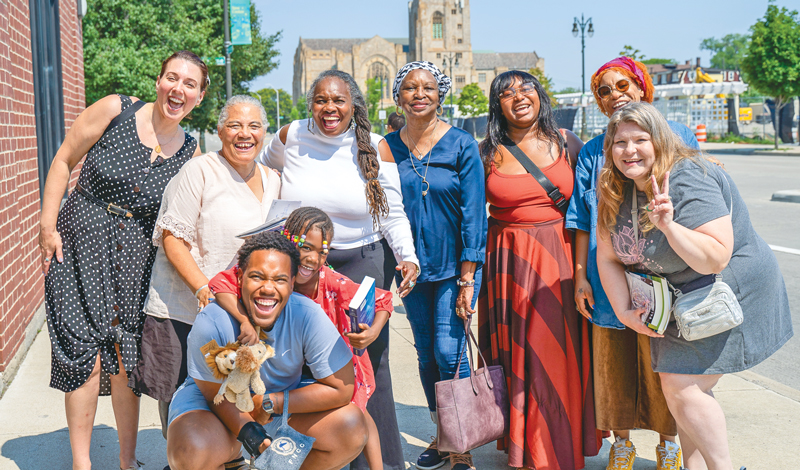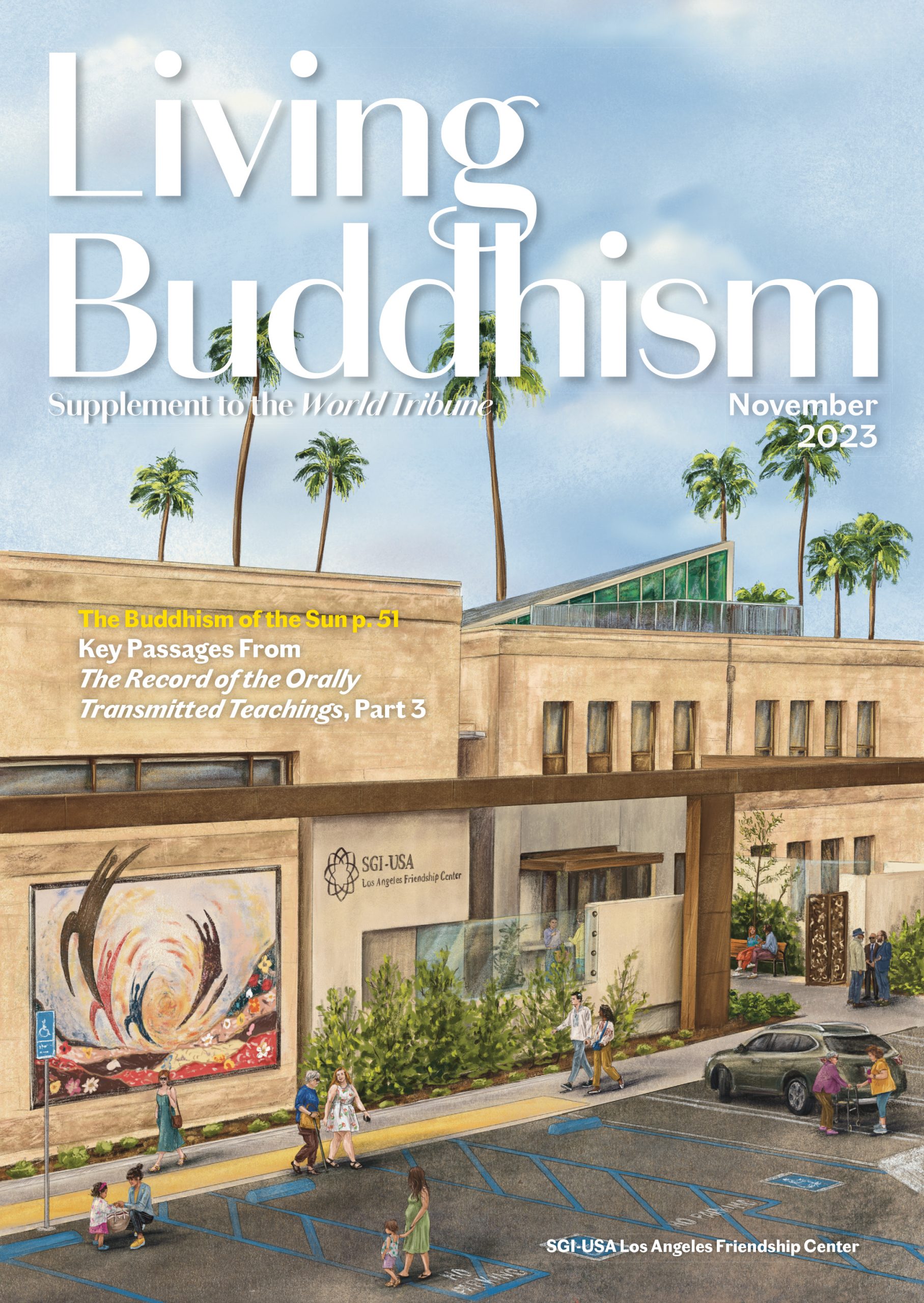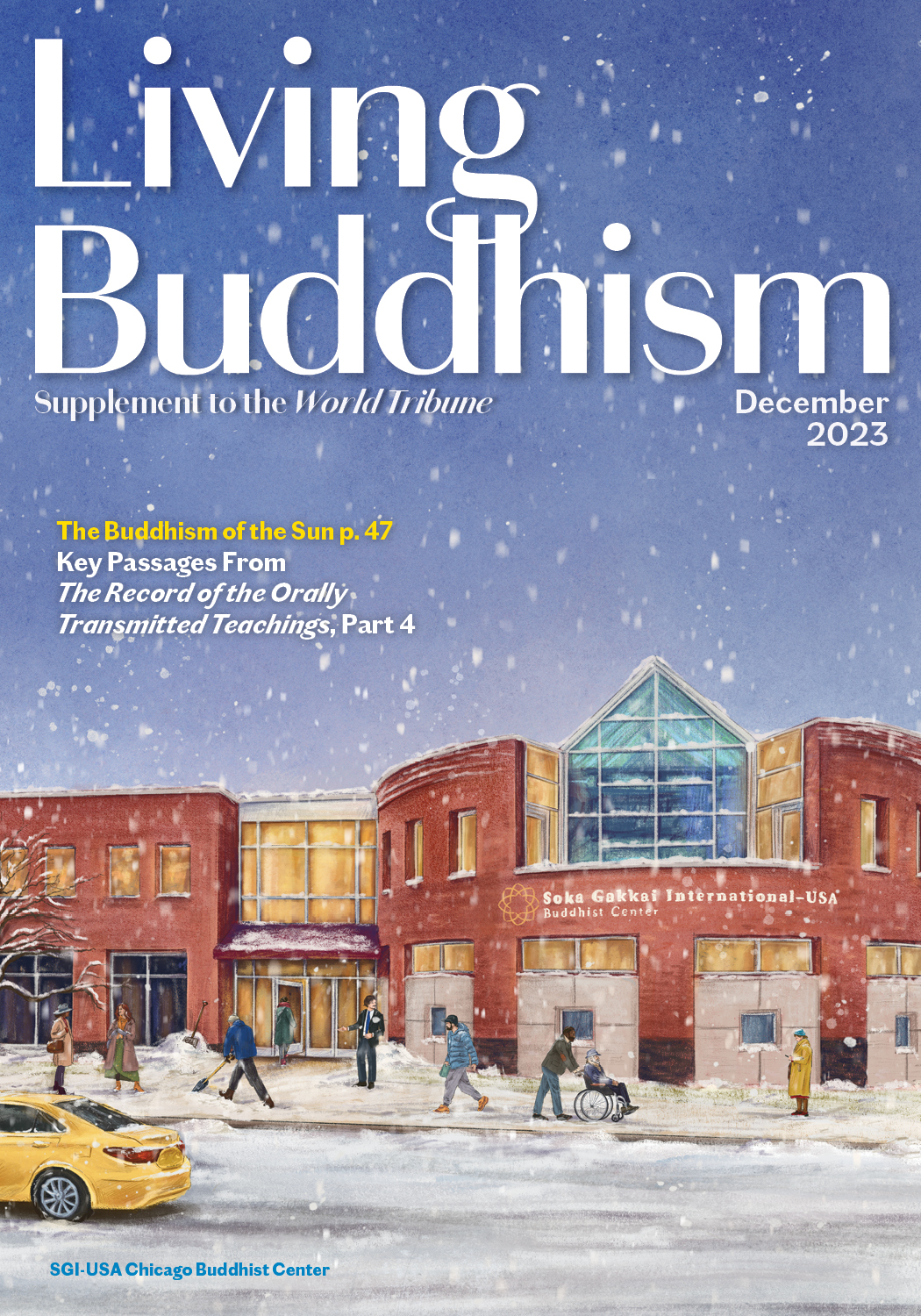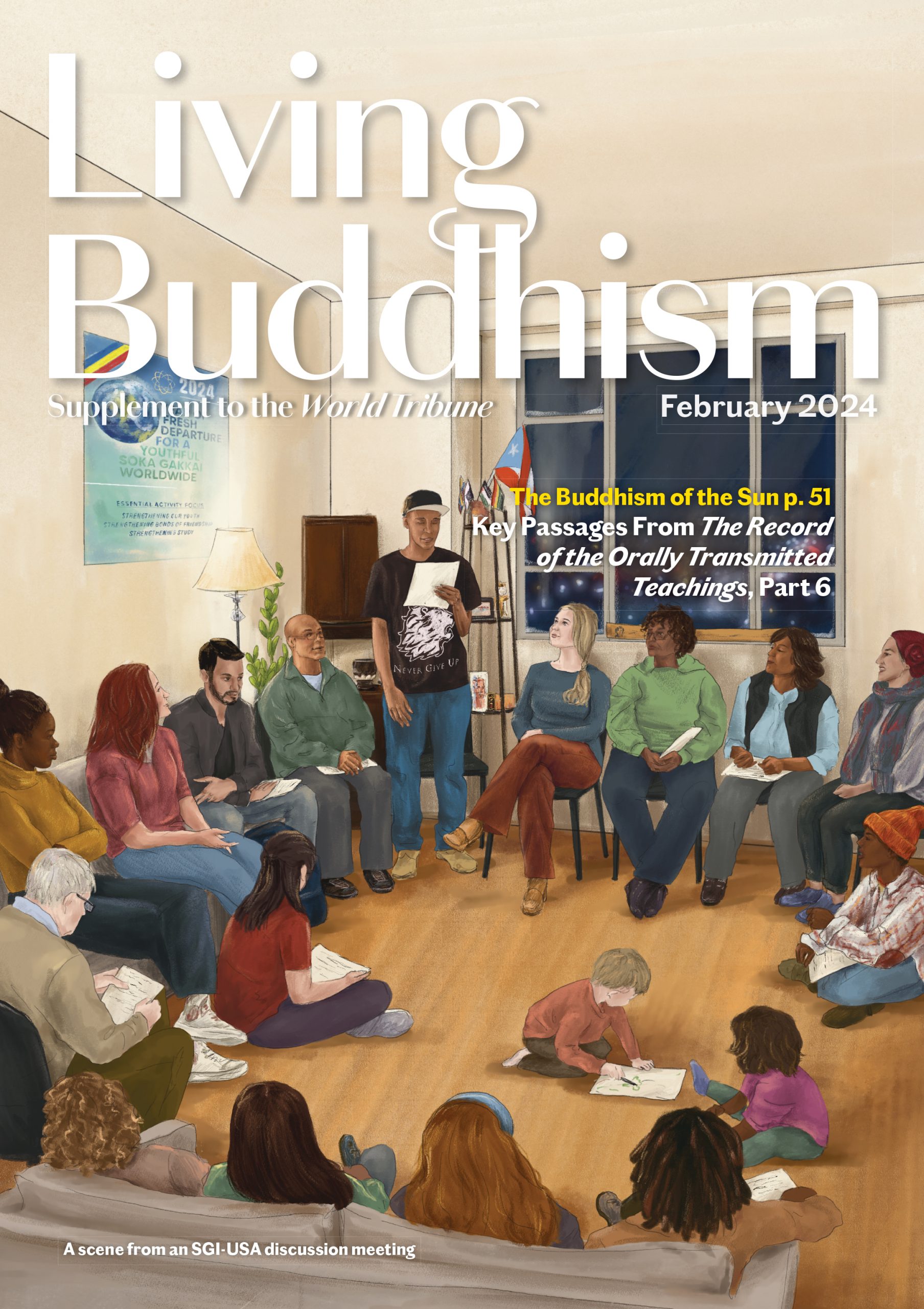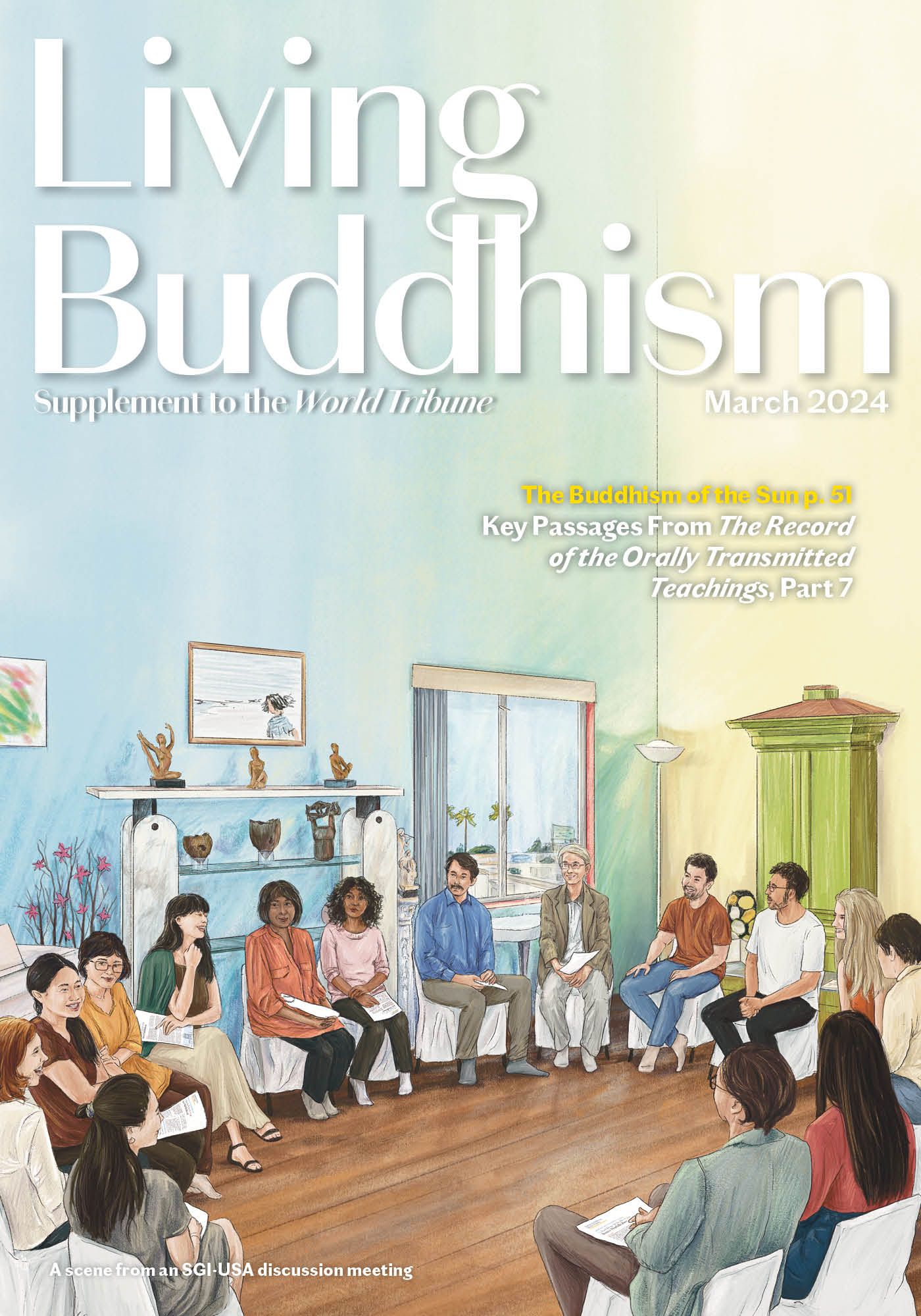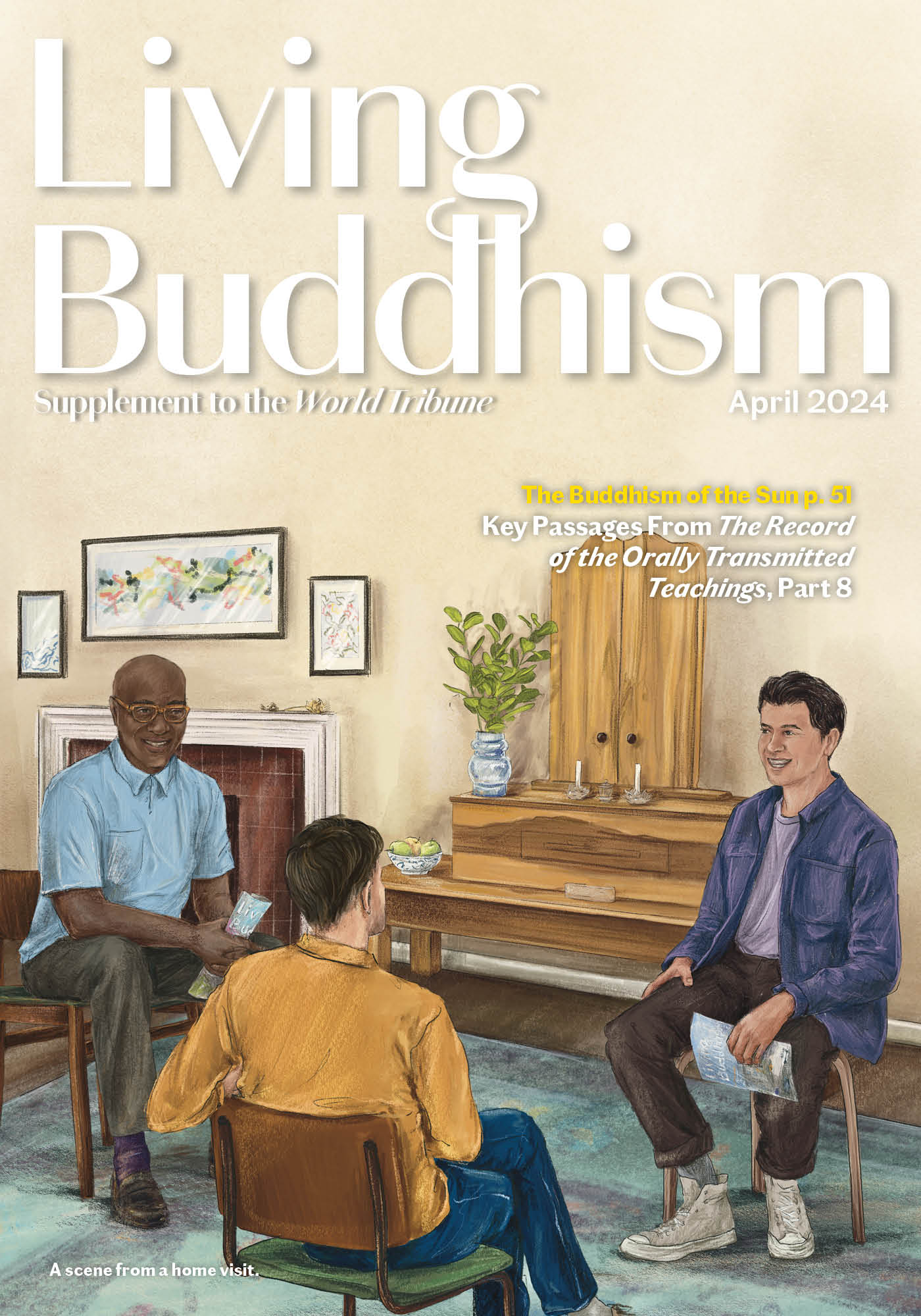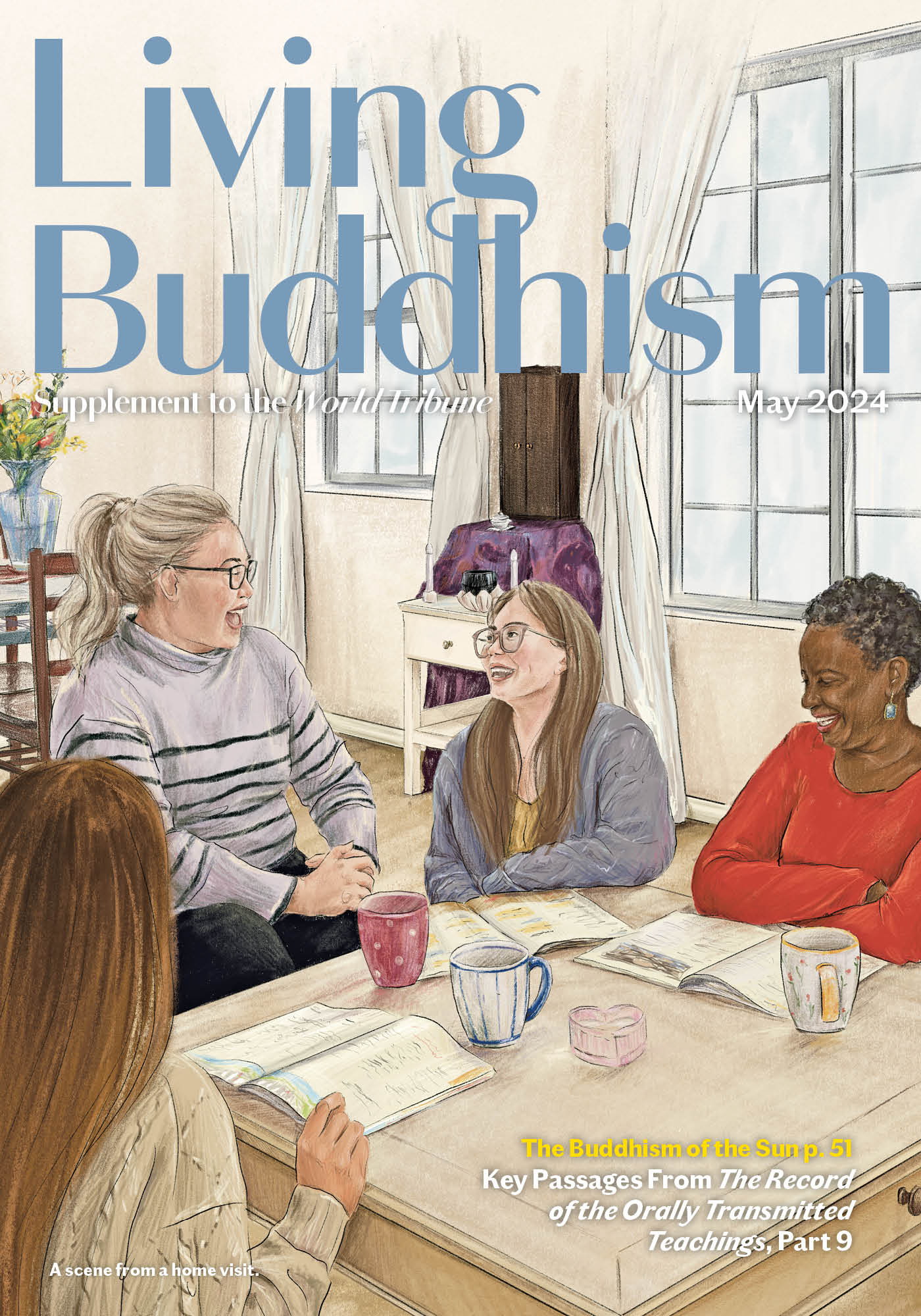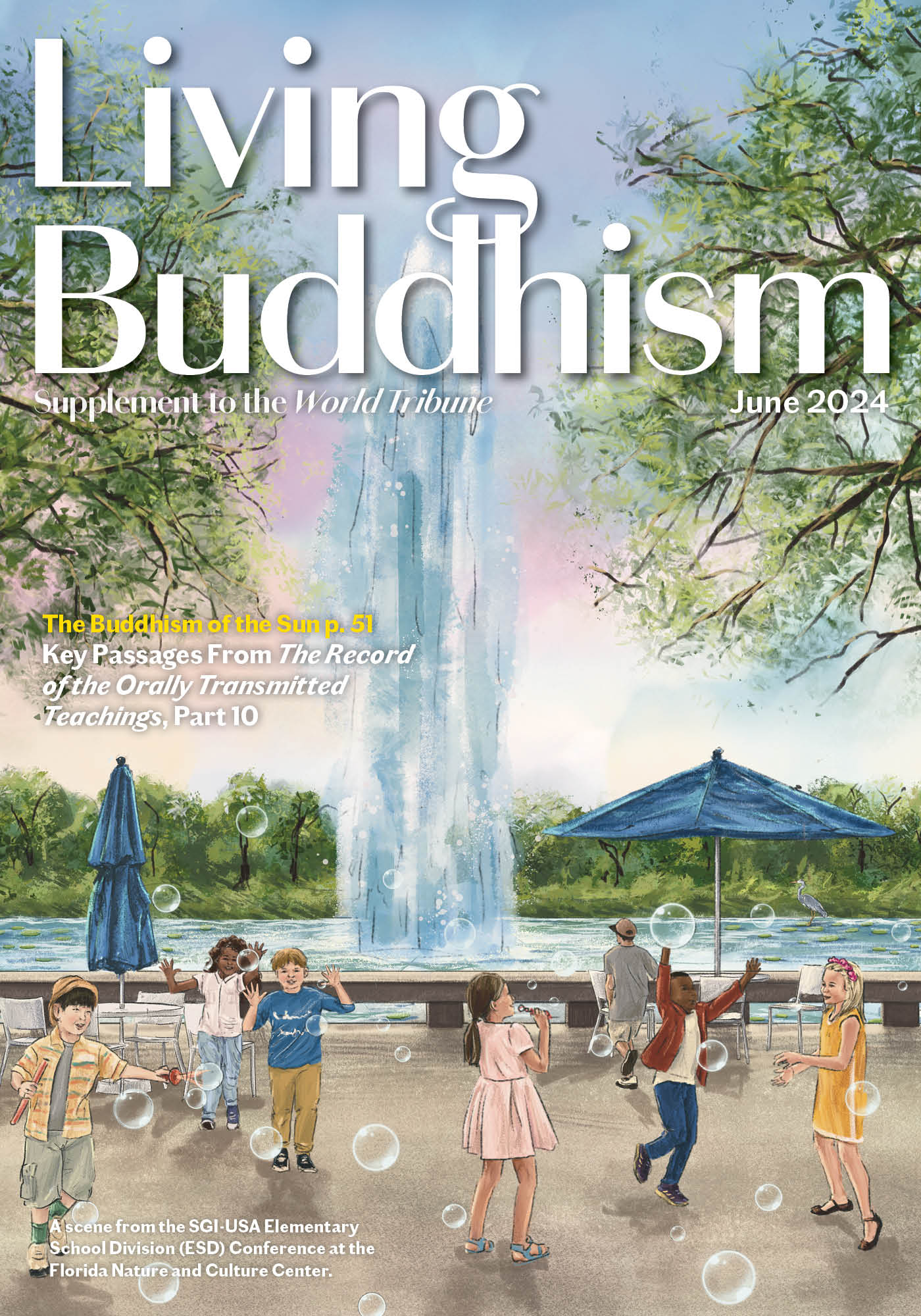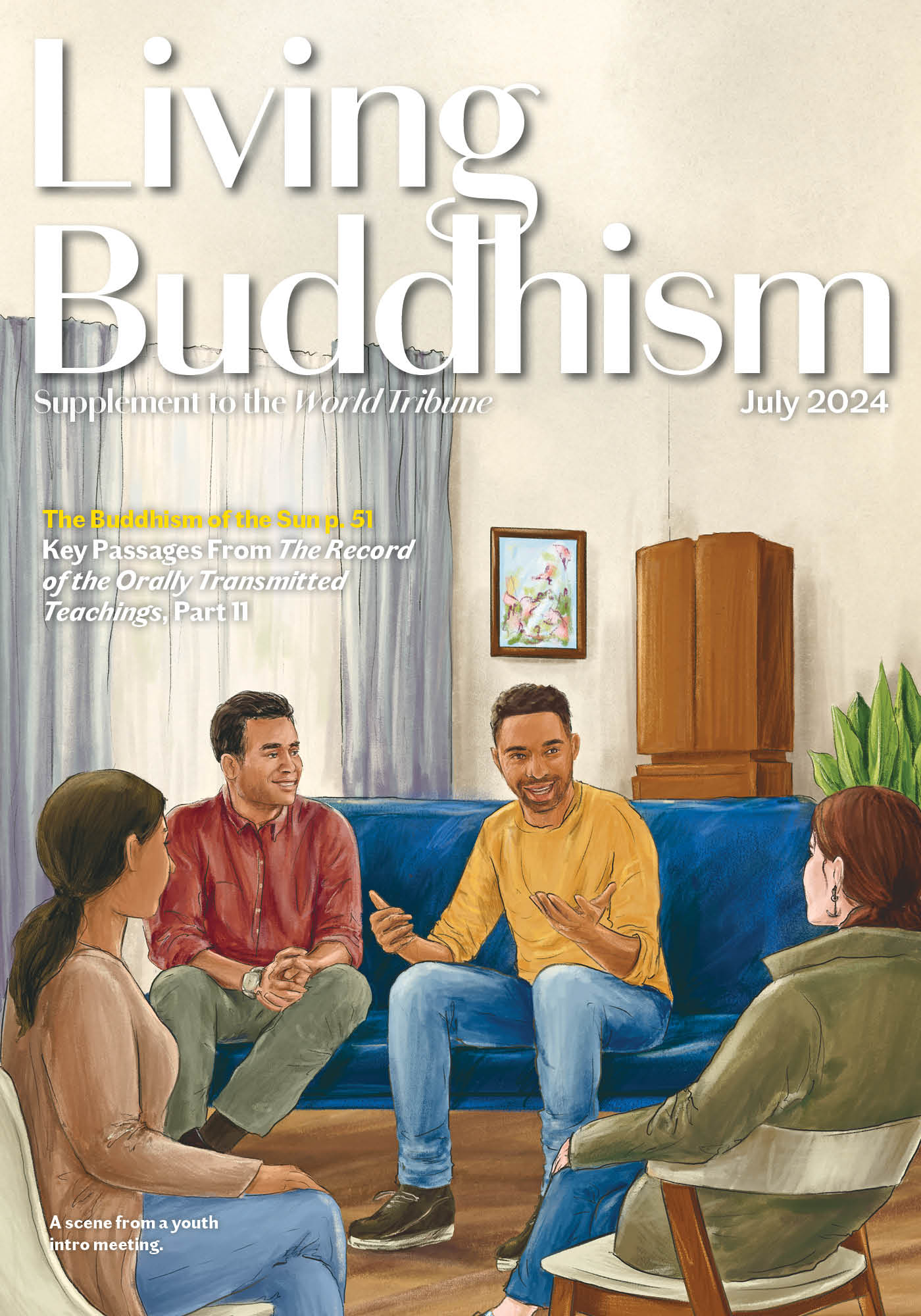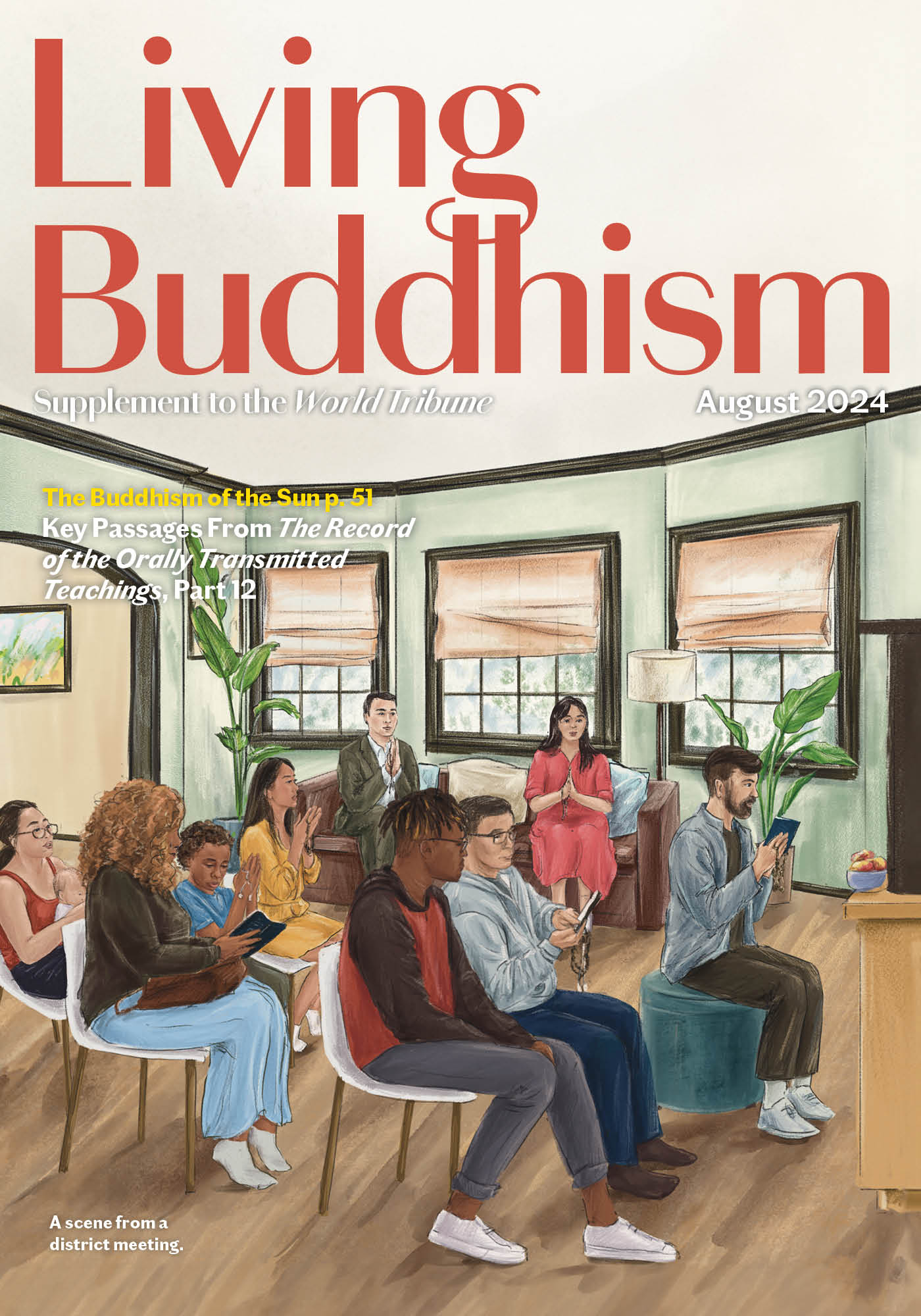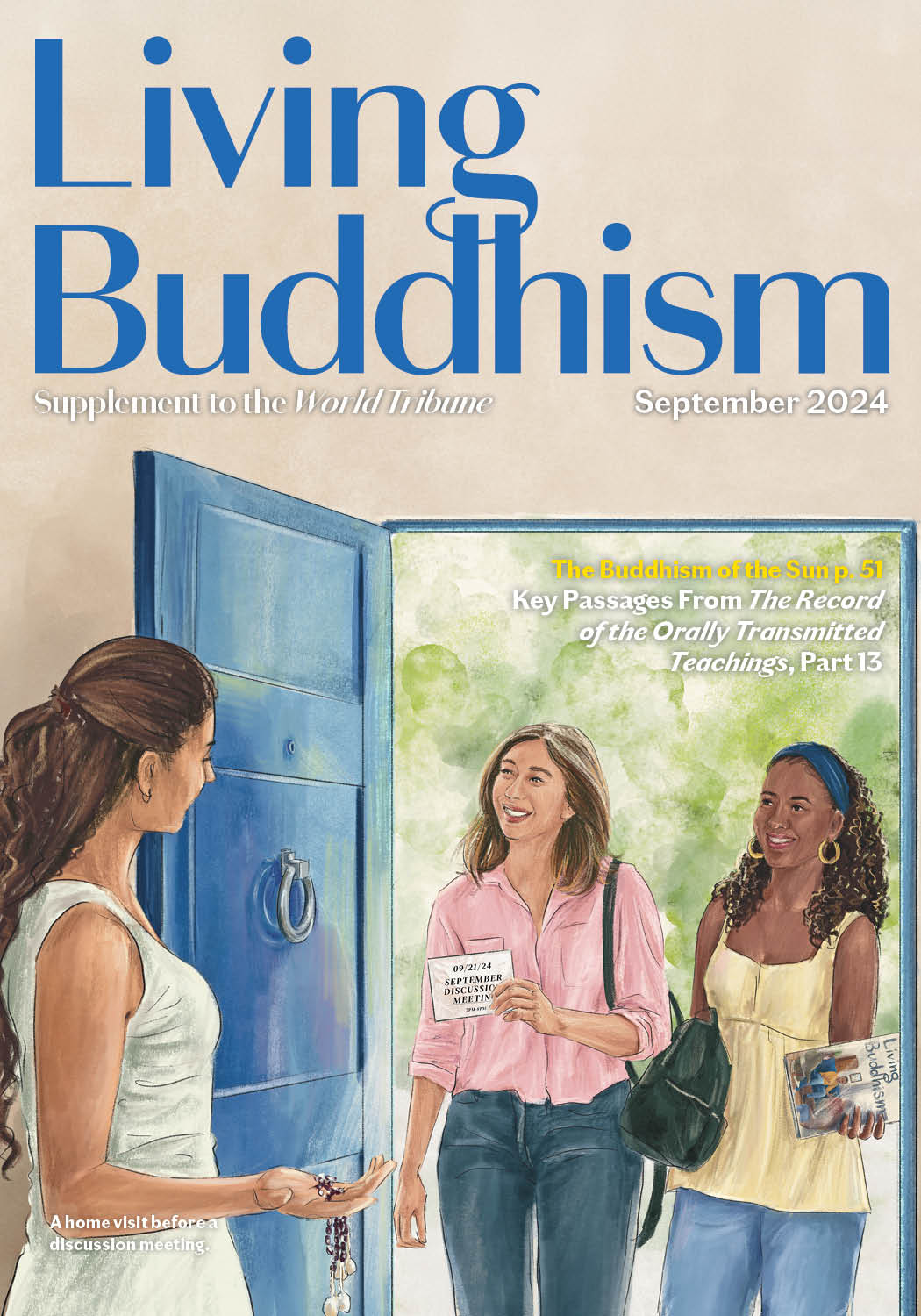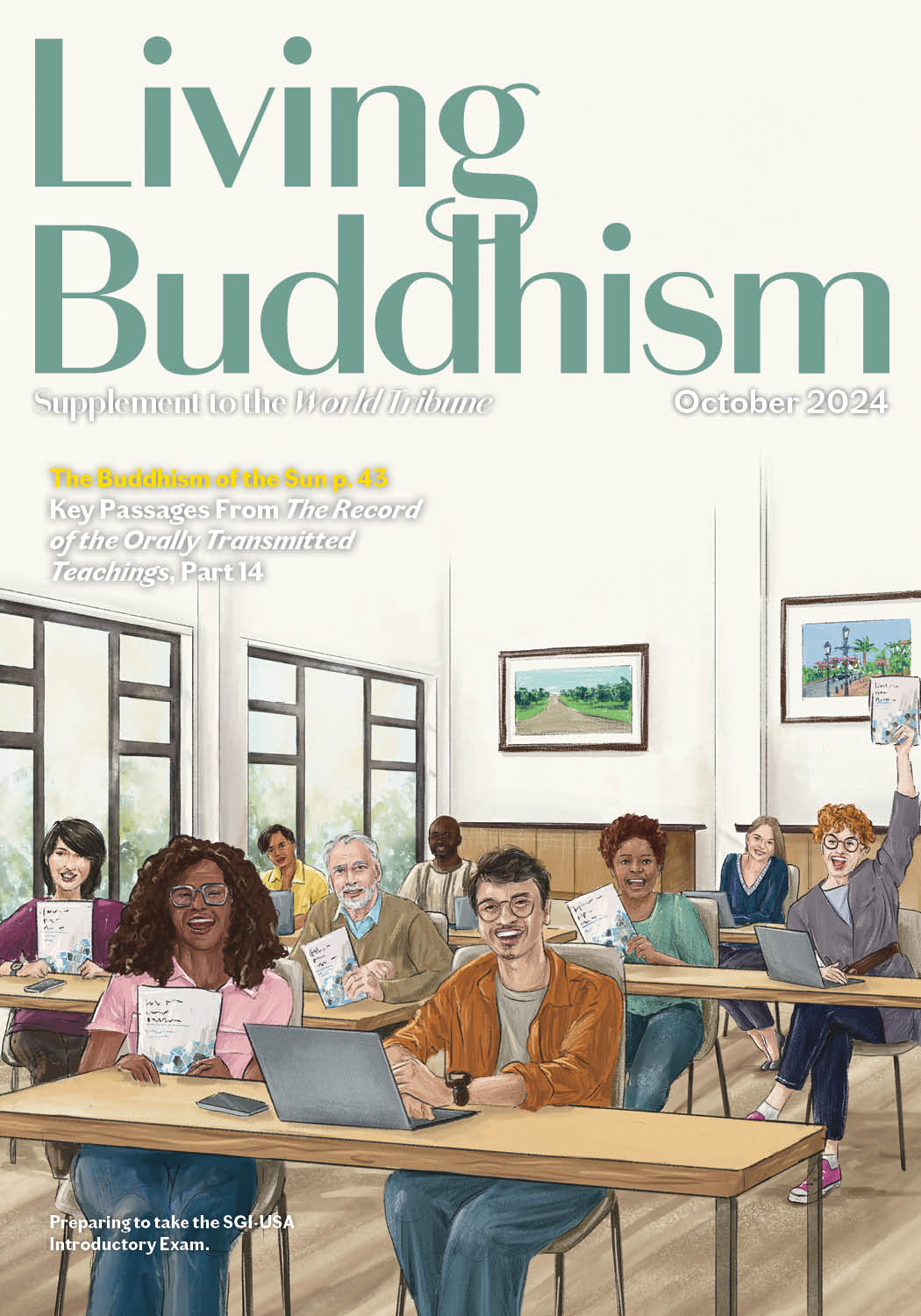Ikeda Sensei’s lecture series “Buddhism of the Sun: Illuminating the World” spans over 100 installments and includes several sub-series. Sensei’s final sub-series written before his passing on November 15, 2023, focuses on The Record of Orally Transmitted Teachings, a collection of Nichiren Daishonin’s lectures on the Lotus Sutra said to be recorded and compiled by his disciple Nikko Shonin.
Consisting of 14 parts, it began in the September 2023 Living Buddhism and concludes in this October 2024 issue. In this lecture series, Sensei affirms how Soka Gakkai members are directly applying what the Daishonin taught in the Orally Transmitted Teachings.
The following highlights from each lecture introduce the theme, excerpts of the Orally Transmitted Teachings passages discussed in the installment and brief guidance from Sensei.
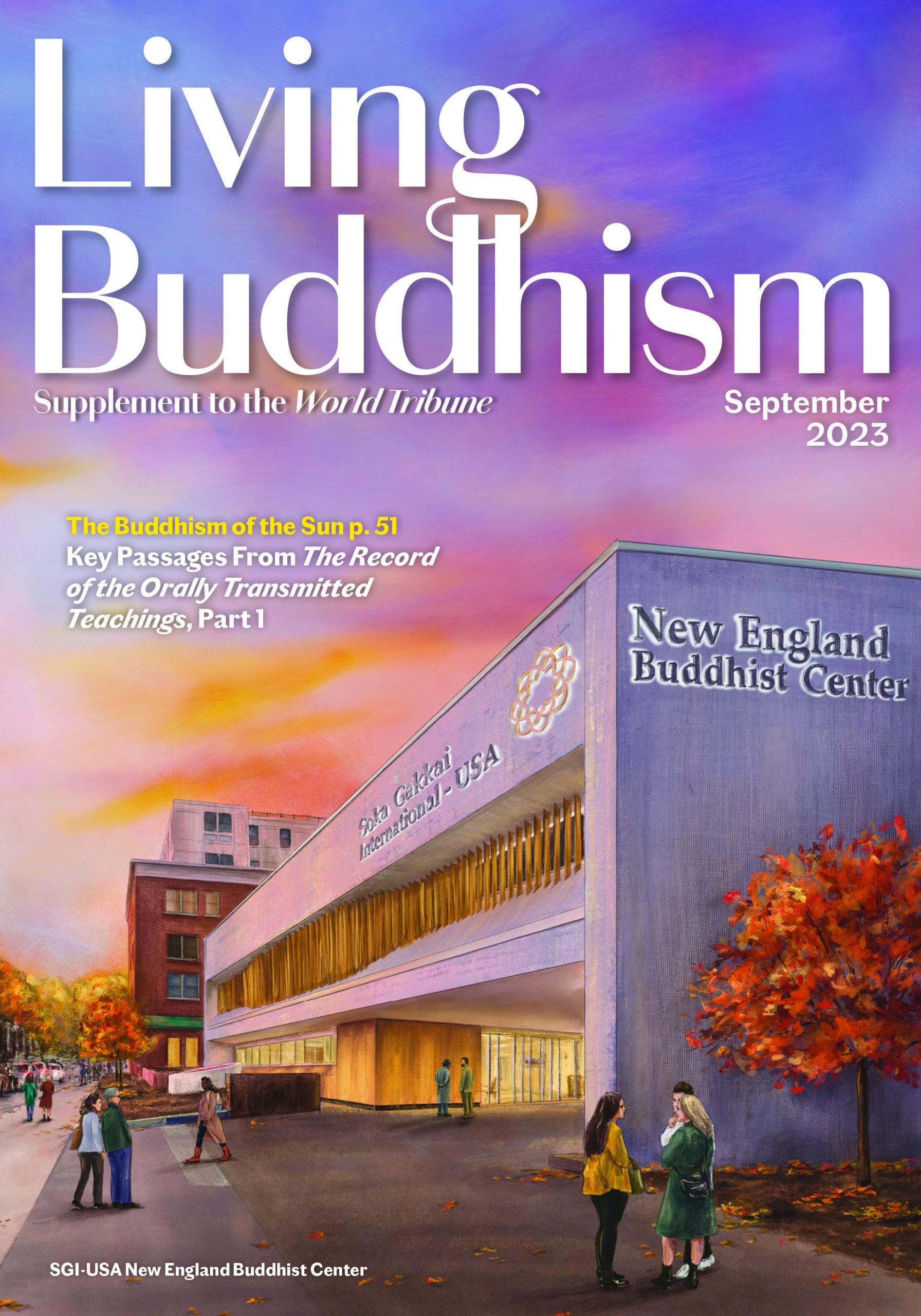
Part 1: Nam-myoho-renge-kyo—Hold High the Banner of Respect for the Dignity of Life! Share the Great Path of the Buddhism of the People! (September 2023 Living Buddhism, pp. 51–62)
Passages Highlighted in This Lecture
Nam-myoho-renge-kyo
The Record of the Orally Transmitted Teachings (Ongi kuden) says: Namu or nam is a Sanskrit word. Here it means to dedicate one’s life… “Dedication” means dedication to the principle of eternal and unchanging truth of the theoretical teaching, and “life” means that one’s life dedicated to that principle bases itself on the wisdom of the truth of the essential teaching that functions in accordance with changing circumstances. In essence, one dedicates one’s life to Nam-myoho-renge-kyo. (The Record of the Orally Transmitted Teachings, p. 3)
•••
Kyo [of Nam-myoho-renge-kyo] represents the words and voices of all living beings. A commentary [by Chang-an] says, “The voice carries out the work of the Buddha, and this is called kyo, or sutra.” (OTT, 4)
Commentary from Ikeda Sensei
Nichiren Daishonin is the Buddha of the Latter Day of the Law who, as an ordinary human being, awakened to, embraced and embodied the Law of Nam-myoho-renge-kyo, the great teaching by which all people can attain Buddhahood. Based on his enlightenment to this ultimate truth, he freely and dynamically lectured on the Lotus Sutra and its opening and closing sutras, giving a living interpretation of them. Nikko Shonin is said to have compiled these precious words and statements of the Daishonin to his disciples. The Record of the Orally Transmitted Teachings is a compilation created through the unity, or oneness, of mentor and disciple. (September 2023 Living Buddhism, p. 53)
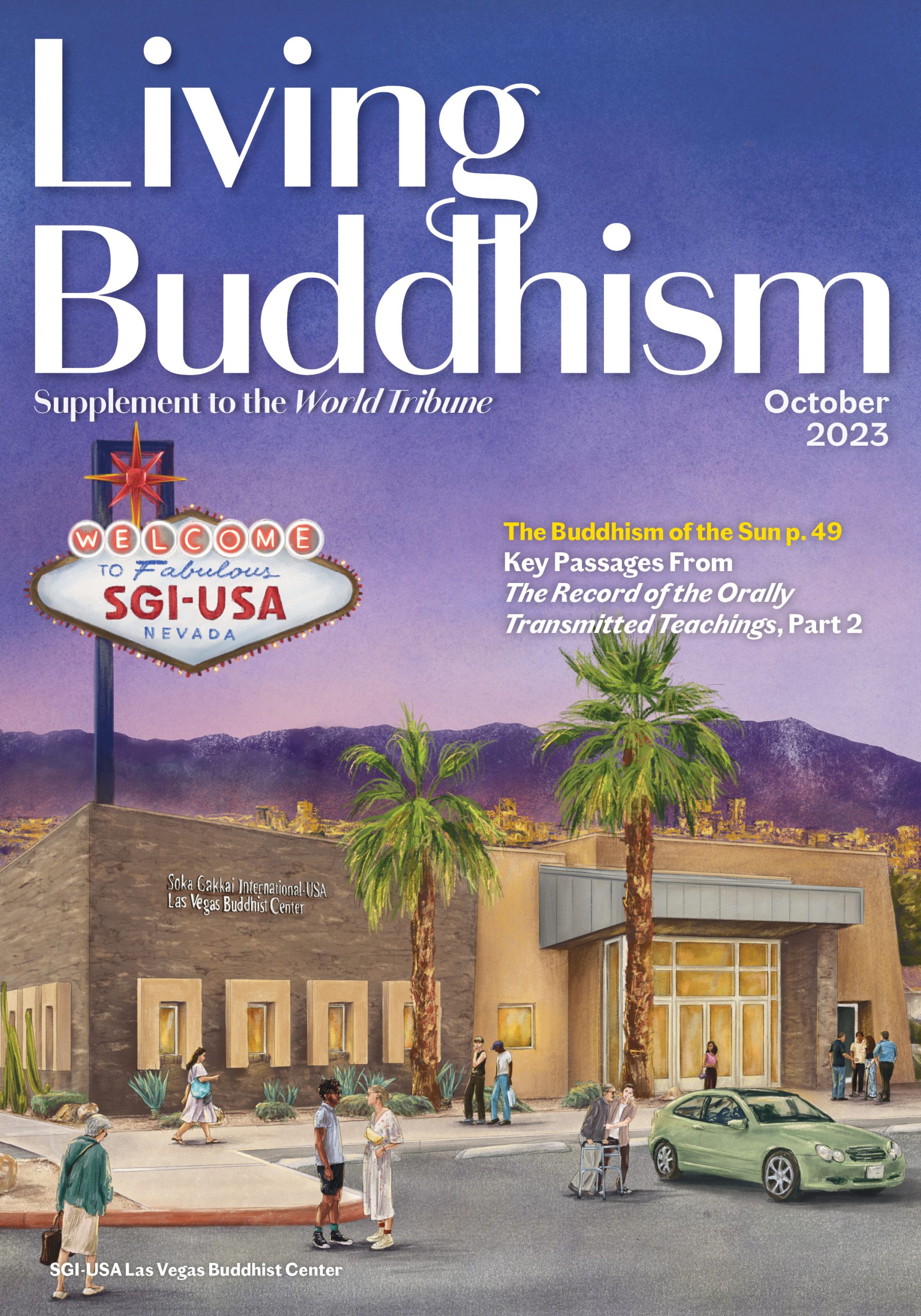
Part 2: ‘Introduction’ Chapter of the Lotus Sutra—Burn With the Great Vow for Kosen-rufu! Problems and Struggles Are a Source of Growth(October 2023 Living Buddhism, pp. 49–62)
Passages Highlighted in This Lecture
The word “heard” of “This is what I heard” cannot apply to a person of no faith. But a practitioner of the Lotus Sutra may be said to have “heard” the substance of the doctrine put forth… Nichiren and his followers are persons to whom the phrase “This is what I heard” may apply. (OTT, 9–10)
•••
[When Nichiren and his followers recite Nam-myoho-renge-kyo], they are burning the firewood of earthly desires, summoning up the wisdom fire of bodhi or enlightenment. …
In the end, therefore, we see that this Ajnata Kaundinya is showing that for us, the votaries of the Lotus Sutra, earthly desires are enlightenment, and that the sufferings of birth and death are nirvana. (OTT, 10–11)
Commentary from Ikeda Sensei
“The great vow or desire for kosen-rufu is the loftiest of all earthly desires, the Buddha’s noble wish. Our life state as we burn the firewood of earthly desires with the fire of our vow and advance eternally along the bodhisattva way is identical to the life state of the Buddha. We manifest the world of Buddhahood, just as we are. This is why we can tap limitless strength and unsurpassed wisdom and courage from within us.” (October 2023 Living Buddhism, pp. 60–61)
Part 3: ‘Expedient Means’ Chapter—Part 1 of 2 Awakening to the Truth That All People Are Buddhas (November 2023 Living Buddhism, pp. 51– 62)
Passages Highlighted in This Lecture
Now Nichiren and his followers, who recite Nam-myoho-renge-kyo, are observers of the “secret and wonderful expedient means,” teachings that are within the body of the truth. Therefore, after the title of the sutra, Myoho-renge-kyo, comes the chapter entitled “Expedient Means.” (OTT, 21–22)
•••
Though the words “identical” and “perfect” are different, they are each another name for “wonderful” [myo]. That all living beings are in fact the Buddha of the true aspect of all phenomena is a wonderful thing, an unfathomable thing! But persons who slander the Law are at present unaware of this fact. Therefore it is referred to as being secret. (OTT, 22)
•••
Even persons who are called great slanderers of the Law will in time come to accept and uphold Myoho-renge-kyo—this is the purpose of the “Expedient Means” chapter of the Lotus Sutra. (OTT, 22)
Commentary from Ikeda Sensei
The greatness of Nichiren Buddhism is that it teaches the means by which all people can reveal their innate Buddhahood in their lives here and now, based on the Lotus Sutra’s principle of universal enlightenment. In terms of our practice, this means that by embracing the Gohonzon and chanting Nam-myoho-renge-kyo for our own and others’ happiness, we ordinary people can tap the wisdom and life force of the world of Buddhahood without fail. This is the “secret and wonderful expedient means” in Nichiren Buddhism. (November 2023 Living Buddhism, p. 56)
Part 4: ‘Expedient Means’ Chapter—Part 2 of 2 Developing the Conviction I Embody the Mystic Law!(December 2023 Living Buddhism, pp. 47–57)
Passages Highlighted in This Lecture
We may say that our head corresponds to myo, our throat to ho, our chest to ren, our stomach to ge, and our legs to kyo. Hence this five-foot body of ours constitutes the five characters of Myoho-renge-kyo. …
When we recite Myoho-renge-kyo with the mind of faith, we are in that very act opening the door of Buddha wisdom. (OTT, 28–29)
•••
The “I” here [in the Lotus Sutra passage “at the start I took a vow, / hoping to make all persons / equal to me, without any distinction between us”] refers to Shakyamuni Buddha, who in fact attained Buddhahood in the remote past. This Shakyamuni Buddha of the essential teaching is none other than we, living beings. …
Nichiren and his followers, who today chant Nam-myoho-renge-kyo, are the ones meant here. (OTT, 39–40)
Commentary from Ikeda Sensei
How can we open the door of this Buddha wisdom in our lives? The Daishonin says the key is to “recite Myoho-renge-kyo with the mind of faith” (OTT, 28)—in other words, to chant Nam-myoho-renge-kyo with the conviction that each of us is a supremely noble embodiment of the Mystic Law. That, he explains, is how we attain Buddhahood in our present form. (December 2023 Living Buddhism, p. 51)
Part 5: ‘Simile and Parable’ and ‘Belief and Understanding’ Chapters—The Mystic Law Is the Unsurpassed Treasure Possessed by All (January 2024 Living Buddhism, pp. 51–62)
Passages Highlighted in This Lecture
The Buddha’s great compassion is unceasing. And … his clever wisdom is boundless. …”
The Record of the Orally Transmitted Teachings says: “Great compassion” is like the mercy and compassion that a mother feels for her child. At present it is the mercy and compassion of Nichiren and his followers. (OTT, 43)
•••
Belief represents the value or price we attach to a jewel or treasure, and understanding represents the jewel itself. It is through the one word “belief” that we are able to purchase the wisdom of the Buddhas of the three existences. That wisdom is Nam-myoho-renge-kyo. …
Now when Nichiren and his followers believe in and accept Nam-myoho-renge-kyo, they are gaining possession of a great precious jewel. (OTT, 54–55)
•••
And now in the minds of Nichiren and his followers, what is unsurpassed is Nam-myoho-renge-kyo. …
And without labor or trouble, without religious practices or good deeds, this cluster of unsurpassed jewels can come into our possession through the single word “faith” [i.e., faith in Nam-myoho-renge-kyo]. That is why the passage says that it has “come to us (jitoku) unsought.” (OTT, 58–59)
Commentary from Ikeda Sensei
Nichiren describes the “great compassion” of the Buddha, who wishes for all living beings to attain enlightenment, as being “like the mercy and compassion that a mother feels for her child” (OTT, 43). This “great compassion” is absolute and unconditional, naturally emanating from the Buddha’s state of being. And he adds: “At present it is the mercy and compassion of Nichiren and his followers” (OTT, 43). (January 2024 Living Buddhism, pp. 54–55)
Part 6: ‘The Parable of the Phantom City’ Chapter—The Lotus Sutra Is a Chronicle of the Shared Struggle of Mentor and Disciple Spanning Past, Present and Future (February 2024 Living Buddhism, pp. 51–61)
Passages Highlighted in This Lecture
In effect, now Nichiren and his followers, people who chant Nam-myoho-renge-kyo, gain enlightenment into the fact that our bodies and minds are the Wonderful Law itself, namely, that the phantom city is identical with the treasure land. … In this statement that the phantom city is identical with the treasure land, the single word “identical” is symbolic of Nam-myoho-renge-kyo. Each moment of life in the phantom city is a moment of life in the treasure land. (OTT, 72)
Commentary from Ikeda Sensei
Kosen-rufu is not the end point of the flow—a destination reached after spreading the Mystic Law. It is the flow itself, an unending movement joined by ever-growing numbers of people to spread the Mystic Law. It is the vibrant coursing of a living Buddhism throughout society and the world. The great river of kosen-rufu created through the shared struggle of mentor and disciple is also producing capable individuals who will build a better society. It is a powerful force for actualizing world peace that prioritizes respect for the dignity of life. (February 2024 Living Buddhism, p. 54)
Part 7: ‘The Teacher of the Law’ Chapter—The Great Vow of Kosen-rufu Is the Heart of the Soka Gakkai (March 2024 Living Buddhism, pp. 51–61)
Passages Highlighted in This Lecture
Now Nichiren and his followers, who chant Nam-myoho-renge-kyo, are the greatest among the teachers of the Law. (OTT, 81–82)
•••
Now Nichiren and his followers, who chant Nam-myoho-renge-kyo, are fulfilling these three rules of preaching represented by the robe, the seat, and the room in each moment of their lives.(OTT, 84–85)
Commentary from Ikeda Sensei
Buddhism means being victorious. We cannot brave and overcome the storms of opposition with only halfhearted resolve. That is why the “robe” we must don comprises “the robe that is gentle and forbearing” and “the armor of perseverance” (see OTT, 85).
The “seat” means being ready to “devote oneself to the practice without begrudging one’s life” (see OTT, 85) amid the raging waves of the real world and advancing fearlessly in the face of the devilish nature of arrogant authority. The “room” refers to compassion resembling the “concern that a mother has for her child” (OTT, 85) and also the strength to protect all from harm. (March 2024 Living Buddhism, p. 58)
Part 8: ‘The Emergence of the Treasure Tower’ and ‘Devadatta’ Chapters—Shining Our Brightest Amid the Realities of This World (April 2024 Living Buddhism, pp. 51–61)
Passages Highlighted in This Lecture
The seven treasures are hearing, as in hearing the Law; belief; keeping of the precepts; meditation; diligence; abandoning of attachment to earthly desires; and a sense of shame (or reflecting on oneself). Or again, we may say that they are the seven openings in the head, the eyes, the ears, the nostrils, and the mouth.
Now Nichiren and his followers, who chant Nam-myoho-renge-kyo, are practitioners who are “adorned with the seven treasures.” (OTT, 89)
•••
The Record of the Orally Transmitted Teachings says: In the phrase “a precious jewel,” the word “a” or “one” indicates Myoho-renge-kyo [abbreviated as myoho, or the Wonderful Law]. “Precious” indicates the workings of the Wonderful Law, and the jewel indicates the entity of the Wonderful Law. (OTT, 107–108)
Commentary from Ikeda Sensei
What is the true significance of the treasure tower? What is the meaning of the events described during the Ceremony in the Air? Throughout The Record of the Orally Transmitted Teachings, Nichiren explains that they teach that we ourselves are supremely noble beings who embody the Mystic Law. …
The treasure tower resplendent with seven kinds of gems not only extols the nobility of the Lotus Sutra, but also our nobility as people who embrace and practice the Mystic Law, making the treasure of our lives shine through our Buddhist practice. (April 2024 Living Buddhism, pp. 54–55)
Part 9: ‘Encouraging Devotion’ Chapter—The Soka Gakkai Spirit of Striving in Faith With the Conviction That ‘Hardships Are Badges of Honor’ (May 2024 Living Buddhism, pp. 51–62)
Passages Highlighted in This Lecture
The Record of the Orally Transmitted Teachings says: The word “encouraging” refers to the converting of others. The word “devotion” refers to one’s own practice. Nam-myoho-renge-kyo embraces both the converting of others and one’s own religious practice.
Now Nichiren and his followers are encouraging others to adopt Nam-myoho-renge-kyo and to make it their own practice. (OTT, 109–110)
•••
The Record of the Orally Transmitted Teachings says: The “unsurpassed way” is Nam-myoho-
renge-kyo. Now Nichiren and his followers are even more anxious with regard to Nam-myoho-renge-kyo than they are with regard to their own lives. (OTT, 114)
Commentary from Ikeda Sensei
Today, we of the Soka Gakkai alone have steadfastly engaged in this practice of “encouraging devotion” while experiencing all kinds of hardships and adversity. Chanting and teaching others about Nam-myoho-renge-kyo for our own and others’ happiness is our noble mission as Soka Gakkai members directly connected to Nichiren Daishonin. (May 2024 Living Buddhism, p. 56)
Part 10: ‘Emerging from the Earth’ Chapter—A Noble Life Dedicated to Fulfilling the Mission of the Bodhisattvas of the Earth (June 2024 Living Buddhism, pp. 51–62)
Passages Highlighted in This Lecture
This chapter, “Emerging from the Earth,” is devoted entirely to matters pertaining to the bodhisattvas of the essential teaching, those who were taught and converted by the Buddha in his true identity. The action carried out by the bodhisattvas of the essential teaching is Nam-myoho-renge-kyo. …
Nichiren and his followers, who now chant Nam-myoho-renge-kyo, are all followers of [or people counted among] these bodhisattvas who emerged from the earth. (OTT, 117–18)
•••
Again, the Record of the Orally Transmitted Teachings says that, of all the thousand plants and ten thousand trees in the world, there are none that are not in essence bodhisattvas who emerge from the earth. …
These bodhisattvas are possessors of the essential or original Law. The original Law is Nam-myoho-renge-kyo. (OTT, 119)
Commentary from Ikeda Sensei
All people, whatever their situation or circumstances, who awaken to their mission and take action to spread the Mystic Law “are all followers of [or people counted among] these bodhisattvas who emerged from the earth.” As the Daishonin puts it elsewhere, “If you are of the same mind as Nichiren, you must be a Bodhisattva of the Earth” (“The True Aspect of All Phenomena,” WND-1, 385). (June 2024 Living Buddhism, p. 57)
Part 11: ‘The Life Span of the Thus Come One’ Chapter—Part 1 of 3 Sowing the Seeds of Buddhahood—The Sacred Work of the Buddha to Bring Happiness to All People (July 2024 Living Buddhism, pp. 51–61)
Passages Highlighted in This Lecture
Now it is the understanding of Nichiren and his followers that, generally speaking, the term “Thus Come One” refers to all living beings. More specifically, it refers to the disciples and lay supporters of Nichiren. (OTT, 124)
•••
Now Nichiren and his followers, those who chant Nam-myoho-renge-kyo, are the original lords of teachings of the “Life Span” chapter. …
Only the five characters of the daimoku [Nam-myoho-renge-kyo] constitute the Buddhism of sowing that is suitable for the present time. Thus, the Buddhism of the harvest is for the time when the Buddha was in the world, and the Buddhism of sowing is for the time after his passing. Hence it is the Buddhism of sowing that is needed in the Latter Day of the Law. (OTT, 125–27)
Commentary from Ikeda Sensei
What is the presentsignificance of our dialogue movement?
First, sowing the seeds of Buddhahood is a way to create connections. It is the sacred task of bringing people in touch with the Mystic Law and opening the way to happiness for all. …
Second, sowing seeds of Buddhahood means not discriminating; it is a noble undertaking to bridge divisions and bring people together. …
Third, sowing seeds of Buddhahood means having faith; it is the admirable cause of promoting a way of life based on respect for others. (July 2024 Living Buddhism, p. 59)
Part 12: ‘The Life Span of the Thus Come One’ Chapter—Part 2 of 3 A Sublime State of Being Where We Experience Joy in Both Life and Death (August 2024 Living Buddhism, pp. 51–62)
Passages Highlighted in This Lecture
To look on birth and death with repulsion and try to escape from them is termed delusion, or a viewpoint of acquired enlightenment. Seeing and understanding the originally inherent nature of birth and death is termed awakening, or original enlightenment.
Now when Nichiren and his followers chant Nam-myoho-renge-kyo, they realize the originally inherent nature of birth and death, and the originally inherent nature of ebb and flow. (OTT, 127)
•••
The Buddha of the Lotus that is the entity of the Law (chapter eleven, point six), who is eternally endowed with the three bodies, is Nichiren and his disciples and lay supporters. That is because they embrace the title of honor, Nam-myoho-renge-kyo. (OTT, 128)
Commentary from Ikeda Sensei
By chanting Nam-myoho-renge-kyo, we come to perceive the originally inherent nature of birth and death. That is, we gain deep conviction in the eternity of our lives throughout past, present and future and bring forth the power to live this life in the most meaningful and fulfilling way. And, in accord with the strict Buddhist principle of cause and effect, our victory in this life determines our good fortune in the next.
That is why the Daishonin underscores the importance of “[summoning] up one’s faith … with the profound insight that now is the last moment of one’s life” (“The Heritage of the Ultimate Law of Life,” WND-1, p. 216). We must make each moment of our lives shine its brightest with the awareness that “now is the last moment.” We achieve this, the Daishonin says, when we “chant Nam-myoho-renge-kyo” (OTT, 127). (August 2024 Living Buddhism, p. 57)
Part 13: ‘The Life Span of the Thus Come One’ Chapter—Part 3 of 3 Praying Each Day and Working to Build a World of Happiness Embodying the Words This, My Land, Remains Safe and Tranquil (September 2024 Living Buddhism, pp. 51–62)
Passages Highlighted in This Lecture
Point Fifteen, regarding the passage “When living beings witness the end of a kalpa / and all is consumed in a great fire, / this, my land, remains safe and tranquil, / constantly filled with heavenly and human beings. … ” [LSOC, 272].
The Record of the Orally Transmitted Teachings says: This passage is a hymn of praise on the principle of three thousand realms in a single moment of life revealed in the “Life Span” chapter of the essential teaching. (OTT, 136)
•••
Point Sixteen, on the words “I am the father of this world” [LSOC, 273].
The Record of the Orally Transmitted Teachings says: “I” refers to Shakyamuni Buddha, the father of all living beings. The Lotus Sutra assures us that both the Buddha and the sutra itself possess the three virtues of sovereign, teacher, and parent. (OTT, 137)
•••
Point Nineteen, on the words “At all times I think to myself [literally, make this thought]” [LSOC, 273].
The Record of the Orally Transmitted Teachings says: “At all times” designates the three existences of past, present, and future. “Myself” refers specifically to Shakyamuni Buddha, and in a more general way to the Ten Worlds.
The words “this thought” in the phrase “make this thought” refer to the eternally inherent single thought of Nam-myoho-renge-kyo. … Now the thought expressed by Nichiren and his followers as they chant Nam-myoho-renge-kyo is the thought of great pity and compassion. (OTT, 139–40)
Commentary from Ikeda Sensei
The Soka Gakkai’s emergence is connected directly to the Buddha’s constant thought or wish, encapsulated in the words “At all times I think to myself.” It is an organization in perfect accord with the Buddha’s intent, carrying out the sacred and compassionate work of leading people to enlightenment as the shared vow of mentor and disciple. Mr. Toda regarded each Soka Gakkai member who dedicates themselves to sharing Buddhism as a Buddha.
As ordinary individuals, our members always dive in among the people and seek to elevate the life state of all humanity—to realize what we call worldwide kosen-rufu. They are noble practitioners of the bodhisattva way participating in a great religious movement. No gathering is more lofty or profound. (September 2024 Living Buddhism, p. 60)
Part 14: ‘The Bodhisattva Never Disparaging’ Chapter—Engaging in Dialogue in a Spirit of Friendship and Activating the Goodness in Each Person’s Heart (October 2024 Living Buddhism, pp. 43–54)
Passages Highlighted in This Lecture
Point One, regarding Bodhisattva [Constantly] Never Disparaging
… The name “Never Disparaging” refers to the three inherent potentials of the Buddha nature that is present in the minds of all living beings. The Buddha nature is the Dharma nature. And the Dharma nature is Myoho-renge-kyo. (OTT, 150–51)
•••
Point Thirteen, concerning the passage “Gainer of Great Authority, at that time the four kinds of believers… were for two hundred million kalpas never able to encounter a Buddha, to hear the Law, or to see the community of monks [literally, the sangha, or community of practitioners]. …” [LSOC, 310–11]
The “Buddha” spoken of in this passage, the Buddha of the Latter Day of the Law, is an ordinary mortal and an ordinary priest. The “Law” is the daimoku [Nam-myoho-renge-kyo]. The “community of monks” is we practitioners of the Lotus Sutra. We may be called Buddhas, and we may also be called ordinary priests, because “to have a profound realization of the perfect principle is called being a Buddha” (from volume seven of [T’ien-t’ai’s] The Profound Meaning of the Lotus Sutra). The perfect principle is the Lotus Sutra. (OTT, 157)
•••
[Point Twenty-three, concerning the bow of obeisance related to ignorance]
… When one recognizes this and performs a bow of obeisance, then one is bowing in obeisance to Nam-myoho-renge-kyo, the principle in which good and bad are not two different things, in which correct and incorrect are one and the same. (OTT, 162–63)
Commentary from Ikeda Sensei
The more that people believe in the inherent goodness of human beings, and the more we base our interactions on mutual respect, the stronger the current of respect for the dignity of life will become, spreading throughout the world. Ultimately, this will enable us to put an end to the cycle of conflict and hatred that seems to have defined the karma of humankind and open the way to a new era of mutual understanding and peace building. (October 2024 Living Buddhism, p. 47)
You are reading {{ meterCount }} of {{ meterMax }} free premium articles

